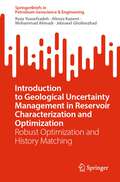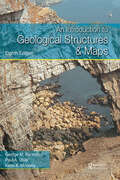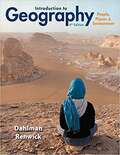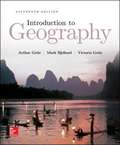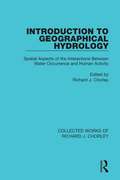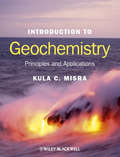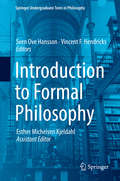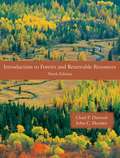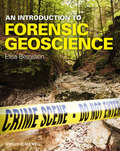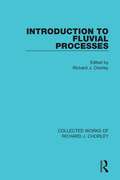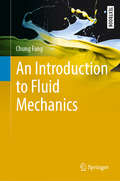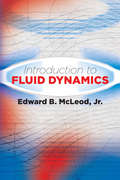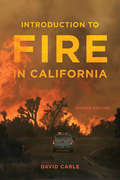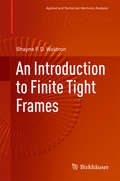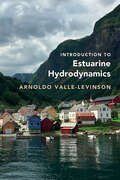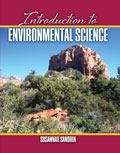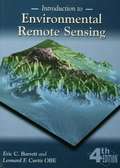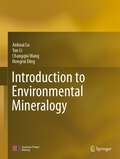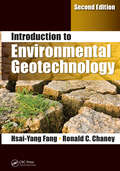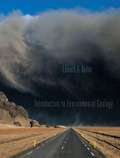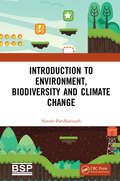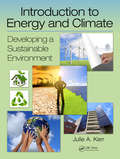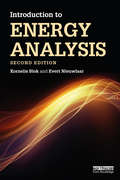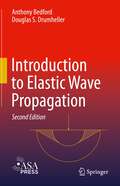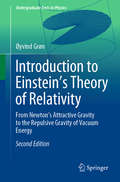- Table View
- List View
Introduction to Geological Uncertainty Management in Reservoir Characterization and Optimization: Robust Optimization and History Matching (SpringerBriefs in Petroleum Geoscience & Engineering)
by Reza Yousefzadeh Alireza Kazemi Mohammad Ahmadi Jebraeel GholinezhadThis book explores methods for managing uncertainty in reservoir characterization and optimization. It covers the fundamentals, challenges, and solutions to tackle the challenges made by geological uncertainty. The first chapter discusses types and sources of uncertainty and the challenges in different phases of reservoir management, along with general methods to manage it. The second chapter focuses on geological uncertainty, explaining its impact on field development and methods to handle it using prior information, seismic and petrophysical data, and geological parametrization. The third chapter deals with reducing geological uncertainty through history matching and the various methods used, including closed-loop management, ensemble assimilation, and stochastic optimization. The fourth chapter presents dimensionality reduction methods to tackle high-dimensional geological realizations. The fifth chapter covers field development optimization using robust optimization, including solutions for its challenges such as high computational cost and risk attitudes. The final chapter introduces different types of proxy models in history matching and robust optimization, discussing their pros and cons, and applications. The book will be of interest to researchers and professors, geologists and professionals in oil and gas production and exploration.
An Introduction to Geological Structures and Maps, Eighth Edition
by George M Bennison Paul A Olver Keith A MoseleyAn Introduction to Geological Structures and Maps is a concise and accessible textbook providing simple structural terminology and map problems which introduce geological structures. It is a perfect introduction to mapping for students of geology, engineering geology and civil engineering.Each topic is explained and illustrated by figures, and exercises follow on successive maps. If students are unable to complete an exercise, they can read on to obtain more specific instructions on how theory may be used to solve the problem. An appendix at the end of the book provides the solutions.This new, eighth edition contains simplified introductory matter to make the subject as easy to grasp as possible. Colour photographs illustrating geological structures bring the subject to life and a new map from the British Geological Survey illustrates a real area. There is more on outcrop patterns, which will help students to think in 3D, and on structures and the relationship of topography to geological structure. Cliff sections have been added to reinforce the concept of apparent dip. The section on planetary geology has been more closely tied to igneous geology to aid understanding of the connection between the two. Finally, a new map on economic geology has been added for the benefit of engineering students.A geological glossary helps students to understand and memorise key terms and a new, colourful, text design enlivens the appearance of this popular book.
Introduction to Geography: People, Places and Environment
by Carl Dahlman William RenwickIntroduction to Geography: People, Places, & Environment, Sixth Edition introduces the major tools, techniques, and methodological approaches of the discipline through new applied visual features that engage students and reinforce real-world connections. <P><P> The authors emphasize the integration of various aspects of geographic processes and systems by discussing what happens in one set of geographic processes and how that affects others. For example, what happens in economic systems affects environmental conditions; what happens to climate affects political dynamics. The Sixth Edition has been tightly integrated with MasteringGeography™, Pearson’s online homework, tutorial, and assessment product designed to improve results by helping students quickly master concepts.
Introduction To Geography
by Victoria Getis Mark BjellandGetis Introduction to Geography is written to clearly and concisely convey the nature of the field of geography, its intellectual challenges, and the logical interconnections of its parts. Even if students take no further work in geography, they will have come into contact with the richness and breadth of Geography and have new insights and understandings for their present and future roles as informed adults. This new edition provides students content and scope of the subfields of geography, emphasize its unifying themes, and provide the foundation for further work in their areas of interest. A useful textbook must be flexible enough in its organization to permit an instructor to adapt it to the time and subject matter constraints of a particular course. Although Getis Introduction to Geography is designed with a one-quarter or one-semester course in mind, this text may be used in a full-year introduction to geography when employed as a point of departure for special topics and amplifications introduced by the instructor or when supplemented by additional readings and class projects.
Introduction to Geographical Hydrology: Spatial Aspects of the Interactions Between Water Occurrence and Human Activity (Collected Works of Richard J. Chorley #Vol. 408)
by Richard J. ChorleyOriginally published in this form in 1971, the content of this book was originally part of a larger composite volume ‘Water, Earth and Man’ (1969) which provided a synthesis of hydrology, geomorphology and socio-economic geography. This volume brings together the systematic theme of spatial aspects of the interactions between water occurrence and human activity.
Introduction to Geochemistry: Principles and Applications
by Kula C. MisraThis book is intended to serve as a text for an introductory course in geochemistry for undergraduate/graduate students with at least an elementary–level background in earth sciences, chemistry, and mathematics. The text, containing 83 tables and 181 figures, covers a wide variety of topics — ranging from atomic structure to chemical and isotopic equilibria to modern biogeochemical cycles — which are divided into four interrelated parts: Crystal Chemistry; Chemical Reactions (and biochemical reactions involving bacteria); Isotope Geochemistry (radiogenic and stable isotopes); and The Earth Supersystem, which includes discussions pertinent to the evolution of the solid Earth, the atmosphere, and the hydrosphere. In keeping with the modern trend in the field of geochemistry, the book emphasizes computational techniques by developing appropriate mathematical relations, solving a variety of problems to illustrate application of the mathematical relations, and leaving a set of questions at the end of each chapter to be solved by students. However, so as not to interrupt the flow of the text, involved chemical concepts and mathematical derivations are separated in the form of boxes. Supplementary materials are packaged into ten appendixes that include a standard–state (298.15 K, 1 bar) thermodynamic data table and a listing of answers to selected chapter–end questions. Additional resources for this book can be found at: www.wiley.com/go/misra/geochemistry.
Introduction to Formal Philosophy (Springer Undergraduate Texts In Philosophy Ser.)
by Sven Ove Hansson Vincent F. Hendricks Esther Michelsen KjeldahlThis Undergraduate Textbook introduces key methods and examines the major areas of philosophy in which formal methods play pivotal roles. Coverage begins with a thorough introduction to formalization and to the advantages and pitfalls of formal methods in philosophy. The ensuing chapters show how to use formal methods in a wide range of areas. Throughout, the contributors clarify the relationships and interdependencies between formal and informal notions and constructions. Their main focus is to show how formal treatments of philosophical problems may help us understand them better. Formal methods can be used to solve problems but also to express new philosophical problems that would never have seen the light of day without the expressive power of the formal apparatus. Formal philosophy merges work in different areas of philosophy as well as logic, mathematics, computer science, linguistics, physics, psychology, biology, economics, political theory, and sociology. This title offers an accessible introduction to this new interdisciplinary research area to a wide academic audience.
Introduction to Forests and Renewable Resources
by Chad P. Dawson John C. HendeeThe introductory course in natural resources is broader and more diverse than ever. Today's students need to know how to manage forest, wildlife, watershed, and range resources in a variety of environments and serving the needs of myriad stakeholders. To that end, Chad Dawson has built on the foundation established by him and the late John Hendee to bring Introduction to Forests and Renewable Resources thoroughly up to date. The Ninth Edition has been reorganized to better address content-for example, policy and the differences between managing federal, state, and private land--that applies to all resources. While forests continue to be emphasized, more coverage is provided to other resources and to achieving management goals for multiple resources when considering topics like fire and recreation.
An Introduction to Forensic Geoscience
by Elisa BergslienAn Introduction to Forensic Geoscience provides fundamental training in geoscience as developed through the lens of its forensic applications. It incorporates a range of topics including geophysical methods of grave detection, the mineralogy of art, identification of microfossils, and comparison of soil trace evidence samples. Each topic is introduced using core concepts that are developed with increasing complexity in order to give readers an understanding of the underlying scientific principles involved and a taste of the wide range of possible forensic uses. A variety of detailed reference tables have been compiled for the text and each chapter contains lists of references to applicable textbooks and journal articles. Examples of real criminal cases are also presented in each chapter to make the connections between theory and real world application. The goal of this book is to give readers a familiarity with the wide range of ways in which geoscience principles and geological materials can be utilized forensically. Additional resources for this book can be found at: http://www.wiley.com/go/bergslien/forensicgeoscience.
Introduction to Fluvial Processes (Collected Works of Richard J. Chorley)
by Richard J. ChorleyOriginally published in this form in 1971, the content of this book was originally part of a larger composite volume ‘Water, Earth and Man’ (1969) which provided a synthesis of hydrology, geomorphology and socio-economic geography. This volume brings together the systematic theme of geomorphology while maintaining a link with the original book which emphasised the benefit of the study of water being considered in the widest sense within the physical and social environments.
An Introduction to Fluid Mechanics (Springer Textbooks in Earth Sciences, Geography and Environment)
by Chung FangThis textbook provides a concise introduction to the mathematical theory of fluid motion with the underlying physics. Different branches of fluid mechanics are developed from general to specific topics. At the end of each chapter carefully designed problems are assigned as homework, for which selected fully worked-out solutions are provided. This book can be used for self-study, as well as in conjunction with a course in fluid mechanics.
Introduction to Fluid Dynamics
by Edward B. Mcleod Jr.Concise, unified, and logical, this introduction to the study of the basic principles of fluid dynamics emphasizes the statement of problems in mathematical language. In addition to its value as a reference for professional engineers, this volume is suitable for advanced undergraduates and graduate students of mathematics and engineering. Some familiarity with the algebra of vector fields is assumed, and a useful appendix provides a succinct review of vector algebra.An introductory chapter covers fundamental notions from the continuum hypothesis to steady-state flow. Succeeding chapters explore conservation of mass, forces acting on a fluid in equilibrium, dynamic equations of motion, irrotational motion, integration of Euler's equation in special cases, and flows representable by harmonic functions. Additional topics include two dimensional flows, rectilinear vortices, general vortex motion, flows with a free boundary, and compressible fluids.
Introduction to Fire in California: Second Edition (California Natural History Guides)
by David CarleThe essential guide to California's long relationship with fire, updated for the climate-change generation. What is fire? How are wildfires ignited? How do California's weather and topography influence fire? How did Indigenous people use fire on the land we now call California? David Carle's clearly written, dramatically illustrated first edition of Introduction to Fire in California helped Californians, including the millions who live near naturally flammable wildlands, better understand their own place in the state's landscape. In this revised edition, Carle covers the basics of fire ecology; looks at the effects of fire on people, wildlife, soil, water, and air; discusses fire-fighting organizations and land-management agencies; and explains how to prepare for an emergency and what to do when one occurs. This second edition brings the wildfire story up to the year 2020, with information about recent extreme and deadly fire events and the evidence that climate change is swiftly changing the wildfire story in California. This update reflects current debates about California's future as a climate-crisis leader facing massive, annual natural disasters; the future of California development and housing; and the critically necessary alternatives to traditional energy options. Features:A larger, more reader-friendly page formatMore than 110 color illustrations and mapsAn overview of major wildfires in California's historyAn updated and expanded discussion of the effect of climate change on fires in natural landscapesTips on what to do before, during, and after firesDiscussion of utility companies and massive power shutoffs
An Introduction to Finite Tight Frames
by Shayne F. WaldronThis textbook is an introduction to the theory and applications of finite tight frames, an area that has developed rapidly in the last decade. Stimulating much of this growth are the applications of finite frames to diverse fields such as signal processing, quantum information theory, multivariate orthogonal polynomials, and remote sensing. Featuring exercises and MATLAB examples in each chapter, the book is well suited as a textbook for a graduate course or seminar involving finite frames. The self-contained, user-friendly presentation also makes the work useful as a self-study resource or reference for graduate students, instructors, researchers, and practitioners in pure and applied mathematics, engineering, mathematical physics, and signal processing.
Introduction to Estuarine Hydrodynamics
by Arnoldo Valle-LevinsonThis textbook provides an in-depth overview of the hydrodynamics of estuaries and semi-enclosed bodies of water. It begins by describing the typical classification of estuaries, followed by a presentation of the quantitative tools needed to study these basins: conservation of mass, salt, heat, momentum, and the thermodynamic equation of seawater. Further topics explore tides in homogeneous basins, including shallow water tides and tidal residual flows, wind-driven flows in homogeneous basins, density-driven flows, as well as interactions among tides, winds and density gradients. The book proposes a classification of semi-enclosed basins that is based on dominant dynamics, comparing forcing agents and restorative or balancing forces. Introduction to Estuarine Hydrodynamics provides an introduction for advanced students and researchers across a range of disciplines - Earth science, environmental science, biology, chemistry, geology, hydrology, physics - related to the study of estuarine systems.
Introduction to Environmental Science
by Susannah SandrinIntroduction To Environmental Science by Susannah Sandrin
Introduction to Environmental Remote Sensing
by Eric C. Barrett Leonard F. CurtisTaking a detailed, non-mathematical approach to the principles on which remote sensing is based, this book progresses from the physical principles to the application of remote sensing.
Introduction to Environmental Mineralogy
by Anhuai Lu Yan Li Changqiu Wang Hongrui DingThis book focuses on the environmental property of minerals including mineralogical record of environmental changes, mineralogical influence on the environmental quality, mineralogical evaluation of the environment, mineralogical processing of environmental pollutants and interaction between minerals and microbes. Understanding of the environmental property of minerals is a good supplement to the traditional concept of “mineral”. By demonstrating plenty of case studies with easy-to-understand figures and tables, this book introduces the environmental effects of interaction between minerals and microbes, physiological and ecological effects of biomineralization, reductive precipitation property of iron sulfide minerals, photocatalytic reduction property of sphalerite, photocatalytic oxidation property of rutile, tubular structure property of chrysotile, tunnel structure property of K-feldspar tetrahedron, tunnel structure property of cryptomelane octahedron, nano property of cryptomelane, crystallization property of jarosite, interaction between semiconducting minerals and microbes, pathological mineralization of human body, mineralogical processing of inorganic pollutants, mineralogical degradation of organic pollutants, mineralogical purification of smoke-type pollutants, mineralogical evaluation of soil environmental quality, mineralogical prevention and control of waste pollutants and mineralogical processing of mine tailings. The book is written for environmental mineralogist as well as postgraduates majoring in environmental science.
Introduction to Environmental Geotechnology
by Hsai-Yang Fang Ronald C. ChaneyThis new edition of a bestseller presents updated technology advances that have occurred since publication of the first edition. It increases the utility and scope of the content through numerous case studies and examples and an entirely new set of problems and solutions. The book also has an accompanying instructor's guide and presents rubrics by which instructors can increase student learning and evaluate student outcomes, chapter by chapter. The book focuses on the increasing importance of water resources and energy in the broader context of environmental sustainability. It’s interdisciplinary coverage includes soil science, physical chemistry, mineralogy, geology, ground pollution, and more.
Introduction to Environmental Geology Fifth Edition
by Edward A. KellerThis text focuses on helping non-science majors develop an understanding of how geology and humanity interact. Ed Keller--the author who first defined the environmental geology curriculum--focuses on five fundamental concepts of environmental geology: Human Population Growth, Sustainability, Earth as a System, Hazardous Earth Processes, and Scientific Knowledge and Values. These concepts are introduced at the outset of the text, integrated throughout the text, and revisited at the end of each chapter. The Fifth Edition emphasizes currency, which is essential to this dynamic subject, and strengthens Keller's hallmark "Fundamental Concepts of Environmental Geology," unifying the text's diverse topics while applying the concepts to real-world examples.
Introduction to Environment, Biodiversity and Climate Change
by Navale PandharinathEnvironment includes air, water, land and the inter relationship between air water, land and human beings and other living creatures, plants micro-organisms and property. Environment effects the wellbeing of man, animal and plants world over. Man is more advanced in intellect and hence it is the duty of man to protect the environment from undesired pollutions. The book discusses various aspects of Global warming, climate change, health hazards, dwindling of forest, water resources and natural resources and stress on biological diversity.Note: T&F does not sell or distribute the Hardback in India, Pakistan, Nepal, Bhutan, Bangladesh and Sri Lanka.
Introduction to Energy and Climate: Developing a Sustainable Environment
by Julie KerrThe purpose of this textbook is to provide a well-rounded working knowledge of both climate change and environmental sustainability for a wide range of students. Students will learn core concepts and methods to analyze energy and environmental impacts; will understand what is changing the earth’s climate, and what that means for life on earth now and in the future. They will also have a firm understanding of what energy is and how it can be used. This text intends to develop working knowledge of these topics, with both technical and social implications. Students will find in one volume the integration and careful treatment of climate, energy, and sustainability.
Introduction to Energy Analysis
by Kornelis Blok Evert NieuwlaarThe energy supply and demand system is of great importance for society, from economic, social, and ecological viewpoints. The last decade in particular has seen rapid changes in the world of energy systems, and it is therefore now an important area for study, academic research, and professional work. This textbook provides an introduction to energy analysis for those students who want to specialise in this challenging field. In comparison to other textbooks, this book provides a balanced treatment of complete energy systems, covering the demand side, the supply side, and the energy markets that connect these. The emphasis is very much on presenting a range of tools and methodologies that will help students find their way in analysing real world problems in energy systems. Featuring learning objectives, further readings and practical exercises in each chapter, An Introduction to Energy Analysis will be essential reading for upper-level undergraduate and postgraduate students with a background in the natural sciences and egineering. This book may also be useful for professionals dealing with energy issues, as a first introduction into the field.
Introduction to Elastic Wave Propagation
by Anthony Bedford Douglas S. DrumhellerThis revised and updated edition expands on its explanations of methods used to analyze waves in solid materials, such as the waves created by earthquakes and the ultrasonic waves used to detect flaws in materials and for medical diagnoses. In addition to the traditional methods used to analyze steady-state and transient waves in elastic materials, the book contains introductions to advanced areas that no other single text covers. These topics include the use of finite elements to solve wave problems, the Cagniard-de Hoop method, the four-pole technique for analyzing waves in layered media, and the growth and decay of shock and acceleration waves. The authors explain the theory of linear elasticity through the displacement equations of motion, methods used to analyze steady-state and transient waves in layered media, and include an appendix on functions of a complex variable. Originally developed for a graduate course for which no suitable text existed, the new edition retains its classroom-tested treatment of the theories of linear elasticity and complex variables for students needing background in those subjects.
Introduction to Einstein’s Theory of Relativity: From Newton’s Attractive Gravity to the Repulsive Gravity of Vacuum Energy (Undergraduate Texts in Physics)
by Øyvind GrønThe revised and updated 2nd edition of this established textbook provides a self-contained introduction to the general theory of relativity, describing not only the physical principles and applications of the theory, but also the mathematics needed, in particular the calculus of differential forms.Updated throughout, the book contains more detailed explanations and extended discussions of several conceptual points, and strengthened mathematical deductions where required. It includes examples of work conducted in the ten years since the first edition of the book was published, for example the pedagogically helpful concept of a "river of space" and a more detailed discussion of how far the principle of relativity is contained in the general theory of relativity. Also presented is a discussion of the concept of the 'gravitational field' in Einstein's theory, and some new material concerning the 'twin paradox' in the theory of relativity. Finally, the book contains a new section about gravitational waves, exploring the dramatic progress in this field following the LIGO observations. Based on a long-established masters course, the book serves advanced undergraduate and graduate level students, and also provides a useful reference for researchers.
